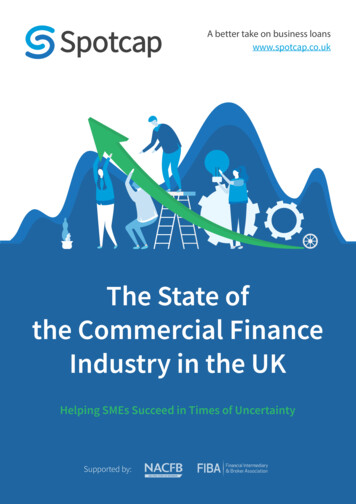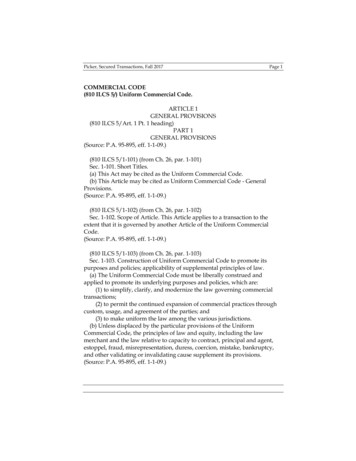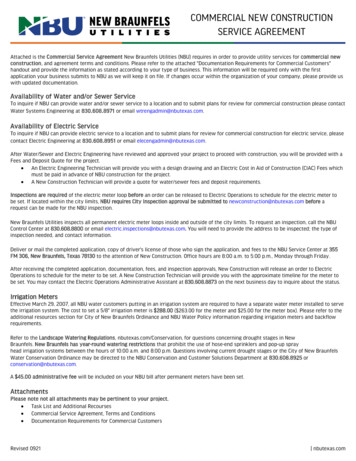
Transcription
A better take on business loanswww.spotcap.co.ukThe State ofthe Commercial FinanceIndustry in the UKHelping SMEs Succeed in Times of UncertaintySupported by:
Table of ContentsAt a Glance.3The UK Commercial Finance Industry Landscape.4Geographical spread.4Funding offered.5Company size and loan volume.5Outlook & Opportunities .7Growth expectations.7Growth opportunities.8Regional breakdown.9Perceived Challenges.11Barriers to growth.11Regional breakdown.12Current gaps in the market.13What’s next?.13Four tips to stay ahead of the game.14
At a GlanceThe commercial finance industry is rapidly changing. Everyone who is part of it wants toknow where we are heading, what’s working and what’s going to change.During July 2019, 132 commercial finance intermediaries, including brokers, businessadvisers and accountants across the UK, took part in our survey. By speaking to thosewho help UK businesses source funding, we wanted to gather more insights into the SMEfinance market. After all, the more we know, the better we’ll be equipped for what liesahead. A special thanks to our partners NACFB and FIBA who supported us in collectingthe responses presented.Key findingsCommercial finance intermediaries have a positive future outlook. Nearly three out offour respondents believe that the number of loans they broker will increase; more than halfof these even go so far to say that they believe it will rise by a lot. Property, professional services, construction and manufacturing are perceived asthe key industries for business growth. They were chosen by over 40 per cent of financialintermediaries when asked: “Which industries do you think will bring in the most newbusiness over the coming year?” The number of documents required to process an application is viewed as a barrierto growth. This is closely followed by generating new business and understanding theoffering of different lenders. Commercial finance intermediaries are divided on Brexit. While approximately one outof four respondents consider the uncertainties around Brexit to be a key challenge, onefifth believe that it will bring new business opportunities. The following report will delve deeper into the survey results – I hope you enjoy the read.Niels TurfboerManaging Director Spotcap.co.uk3
The UK Commercial Finance IndustryLandscapeThe typical commercial finance intermediary works in a denser populated area, for asmaller company and offers five different types of finance, ranging from 100k to 500k.The following sections look into the industry landscape in more detail.Geographical spreadThe majority of the 132 commercial finance intermediaries who took part in the survey arebased in the South East, including Greater London, and the Midlands (Fig. 1).08/08/2019Figure 1Wales 3.79%South West 6.06%Midlands 24.24%North East 6.06%North West 12.88%South East (excl. London)22.73%Greater London 21.97%1/1Fig. 1: Geographical spreadQuestion asked: Which region of the UK are you based in?.co.uk4
Funding offered08/08/2019Service diversi ication matters. Across all respondents, commercial financeintermediaries offer on average 4.8 different types of funding (Fig. 2). Asset finance (77 per cent), unsecured finance (75 per cent) and property finance (73per cent) are the most popular More than one out of ten respondents are specialised and offer only one type offundingFigure 2Asset financeUnsecuredProperty finance76.6975.1972.93Factoring / InvoiceCash advanceHire / Leasing64.6659.4057.89Fig. 2: Funding offeredQuestion asked: What type of finance do you or your company offer?Company size and loan volumeCompany size (Fig. 3) Approximately one out of five respondents run a one-man-band operation and workon their own Almost half of all respondents work for smaller companies and brokerages, rangingfrom two to ten employees.co.uk1/15
08/08/2019Figure 36.82%3.03%18.18%2-10149.24%10-50100 50-10022.73%Fig. 3: Company sizeQuestion asked: How many people are employed in your company?1/1Loan size (Fig. 4) Approximately one third of intermediaries secure smaller loan amounts of up to 100kfor their clients 45 per cent of the respondents help their clients source funding in the range of 100k to 500k per loan08/08/2019Figure 4Between 1m and 5m 7.69%Between 500k and 1m11.54%Between 100k and 500k45.38%Up to 100k 35.38%Fig. 4: Average loan sizeQuestion asked: What is your average loan size?.co.uk1/16
Combined deal value (Fig. 5) In 2018, approximately three out of ten intermediaries brokered between 5m- 20m infunding to UK SMEs 24 per cent of all respondents have arranged deals in total of 20m last year08/08/2019Figure 54.55%9.09%28.79%Between 5m to 20m12.88%Between 1 and 5mUp to 1mBetween 20m to 50m50m Other20.45%24.24%Fig. 5: 2018 combined deal valueQuestion asked: Approximately, what is the combined value of the deals you successfullybrokered in 2018?1/1Outlook & OpportunitiesGrowth expectationsWhen asked whether they believe the number of loans they broker over the next twelvemonths will increase or decrease, almost three out of four respondents expect the numberto rise; 56 per cent even think it will do so considerably (Fig 6). This reflects the optimisticnature of many intermediaries, with most of them keen to explore new opportunities. Sowhy are most intermediaries so optimistic? What will drive business growth?.co.uk7
08/08/2019Figure 6Stay the same 10.61%Decrease slightly12.12%Increase slightly43.18%Increase by a lot 34.09%1/1Fig. 6: Growth expectationsQuestion asked: Compared to the last 12 months, do you expect the number of loans youbroker in the next 12 months to:Growth opportunitiesFor two thirds of respondents, attracting new clients is key, followed by new productofferings which 42 per cent see as an opportunity (Fig. 7).What’s more, one out of five intermediaries believe that the developments around Brexitoffer opportunities for their business. The commercial finance industry clearly embracesthe nature of SME lending with its constant innovation and change.08/08/201970Figure 76960Percentage (%)504240303029232021100Attracting new clientsNew productofferingsDiversifying portfolioofferingNew tech andinnovationBetter understandclient needsDevelopmentsaround Brexit1/1Fig. 7: Growth opportunitiesQuestion asked: What do you think are the main opportunities to grow your business?.co.uk8
Industry insight – Sarah Fisher, Head of CorporateDevelopment, Fortis Corporate LendingNew leads don’t just go from lenders to commercial financeintermediaries – it flows the other direction as well“We are working alongside funders in the market where they provide uswith warm leads when a direct application to the funder has not beensuccessful. Instead of receiving a decline and being sent to the marketto fend for him or herself, the client is taken on a journey that results infunding in some format. We have seen great success with this model andare looking to expand this element.”UK industry new business potentialThe four industries which – according to the respondents – have the highest potentialto bring in new business are property, professional services, construction andmanufacturing (Fig. 8).Regional breakdown Almost a quarter of respondents in Greater London and the North West believe thatprofessional services and property will be key sectors over the next twelve monthsManufacturing industries are expected to bring in the most business for intermediariesbased in the Midlands and the North West, but aren’t considered to be a priority in theSouth East and Greater London.co.uk9
08/08/2019PropertyFigure 8 (Regions)Professional servicesGreater 3.24%26.39%UK12.50%13.24%9.72%Figure 8 (UK)Professional services ConstructionWholesaleNorth EastProperty 20.00%20.00% Manufacturing Retail30.00%South East (excl. Fig. 8: UK industry opportunitiesQuestion asked: Which industries do you think will bring in the most business overthe next year? Please select your top three.1/1Industry insight – Simon Lort, Regional AccountDirector, LUV Asset FinanceManufacturing awaits boost“Once Brexit is completed – either way – I believe UK manufacturing willreceive a significant boost. This will come from either new world tradedeals, or in the case of remain, new and increased orders from Europe.In both scenarios, financial support will be high on the agenda to aidservicing.”.co.uk10
Perceived ChallengesDespite the optimistic outlook, commercial finance intermediaries also highlight a numberof challenges which will be explored in more detail in this section.Barriers to growth The biggest challenge for almost half of the commercial finance intermediaries whoparticipated in the survey was the number of documents required to process anapplication (Fig. 9)Additional challenges mentioned by approximately four out of ten respondents are: Generating new business Understanding the offering of the different lenders Uncertainties around Brexit08/08/201950Figure 94740403838353230Percentage (%) 201713100DocumentrequirementsGenerating newbusinessBrexituncertaintyDifferences inlender offeringsTime involvedMeeting clientdemandsEconomicclimateKeeping up withinnovation1/1Fig. 9: Growth challengesQuestion asked: What are your biggest challenges when it comes to commercialfinance?.co.uk11
Industry insight – Paul Stanley, Commercial FinanceSpecialist, Synergy Commercial FinanceA generic application process across major lenders isneeded“I used to be in the life and pensions industry where every company hadits own application documentation. It was a nightmare for advisors andresulted in loads of completion errors. Over time a generic applicationform was developed which the majority of life offices accepted. A similargeneric application process across major lending would aid consistencyof completion.”Regional breakdownLooking at the different regions, challenges vary. Almost one fifth of intermediaries based in the South East (excluding Greater London)are the most anxious about Brexit, compared to intermediaries in the North West, theMidlands and Greater LondonOne out of five respondents based in the Midlands are keen to get on top ofunderstanding the offerings of the different lenders. This is the highest percentage outof all the regions.co.uk12
08/08/2019Figure 10 (regions)Document requirementsGenerating new businessGreater LondonSouth East (excl. London)Different lender offerings30.19%Client demands11.32%20.83%18.06%Brexit uncertainty11.32%11.11%8/20/2019Economic climate15.09%12.50%Keeping on top of innovation15.09%9.43% 7.55%20.83%13.89%Figure 10 ting new businessNorth East23.53%UK21.31%23.17%Client's demandsDifferent lender offerings11.76%17.87%17.07%Economic climate14.63%7.32%Keeping on top of innovationBrexit 7.56% 5.50%Fig. 10: Growth challenges – regional breakdownQuestion asked: What are your biggest challenges when it comes to commercial finance?1/1Current gaps in the marketAs part of the survey, we also asked respondents what they believe are current gaps in themarket. The following trends emerged: A fully unsecured loan with a duration of five years The introduction of an escalator loan where the value scales up as the company grows Smaller, longer term loans for younger companiesWhat’s next?Recent statistics from the Bank of England have shown that SME borrowing reached a twoyear high in June 2019, increasing by 375m, a growth rate of 0.8 per cent. That said, theBank also confirmed that there is still a 22bn funding gap in the SME loan market, withmany businesses struggling to obtain capital to finance growth opportunities. There isclearly potential for commercial finance intermediaries and lenders to fill this gap.co.uk13
The survey responses are an indicator for intermediaries of where the industry is heading– and for lenders of how they can add more value to both intermediaries and SMEs.Relevant questions to consider include: Attracting new clients and generating new business is seen both as an opportunity anda challenge. How can a culture of innovation and change be nurtured to stay ahead ofthe game? How can the loan application process be simplified further, for example by reducing theamount of documents? What are additional ways to educate intermediaries about SME funding options? And how can lenders help intermediaries plan ahead given the current macroeconomicclimate and discussions around Brexit?One thing is clear, the SME funding landscape is constantly changing. The more adaptableand flexible intermediaries as well as lenders are, the better and faster they can compete,grow their business and support UK SMEs.Four tips for intermediaries to stay ahead of the gameLearnKeep on top of what’s out there inthe market by attending conferences, roundtables and speakingto lenders directly.Stay informedKeep up to date with nationalnews and regularly exchangeviews with your network to detecttrends and opportunities early.co.ukFind your gap inthe marketThink about ways your offeringor service can differ from otherintermediaries to stay ahead ofthe game.Keep an open mindDon’t be fearful – embracechance. It goes hand in hand withopportunity.14
About SpotcapSpotcap empowers small and medium-sized businesses withunsecured finance, allowing them to focus on what really matters.With the help of our in-house developed technology, combined withexpert underwriters, we are able to provide a credit decision withinone working day.Get in touchFor further information about Spotcap’s unsecured businessloans and how to partner with us, please contact our clientservice team on 0203 308 9188 clientservice@spotcap.co.ukor visit:www.spotcap.co.uk/partners
Factoring / Invoice 64.66 Cash advance 59.40 Hire / Leasing 57.89 Unsecured 75.19 Asset finance 76.69 Company size and loan volume Funding offered Service diversiication matters. Across all respondents, commercial finance intermediaries offer on average 4.8 different types of funding (Fig. 2). Asset finance (77 per cent), unsecured finance (75 per cent) and property finance (73 per cent .











